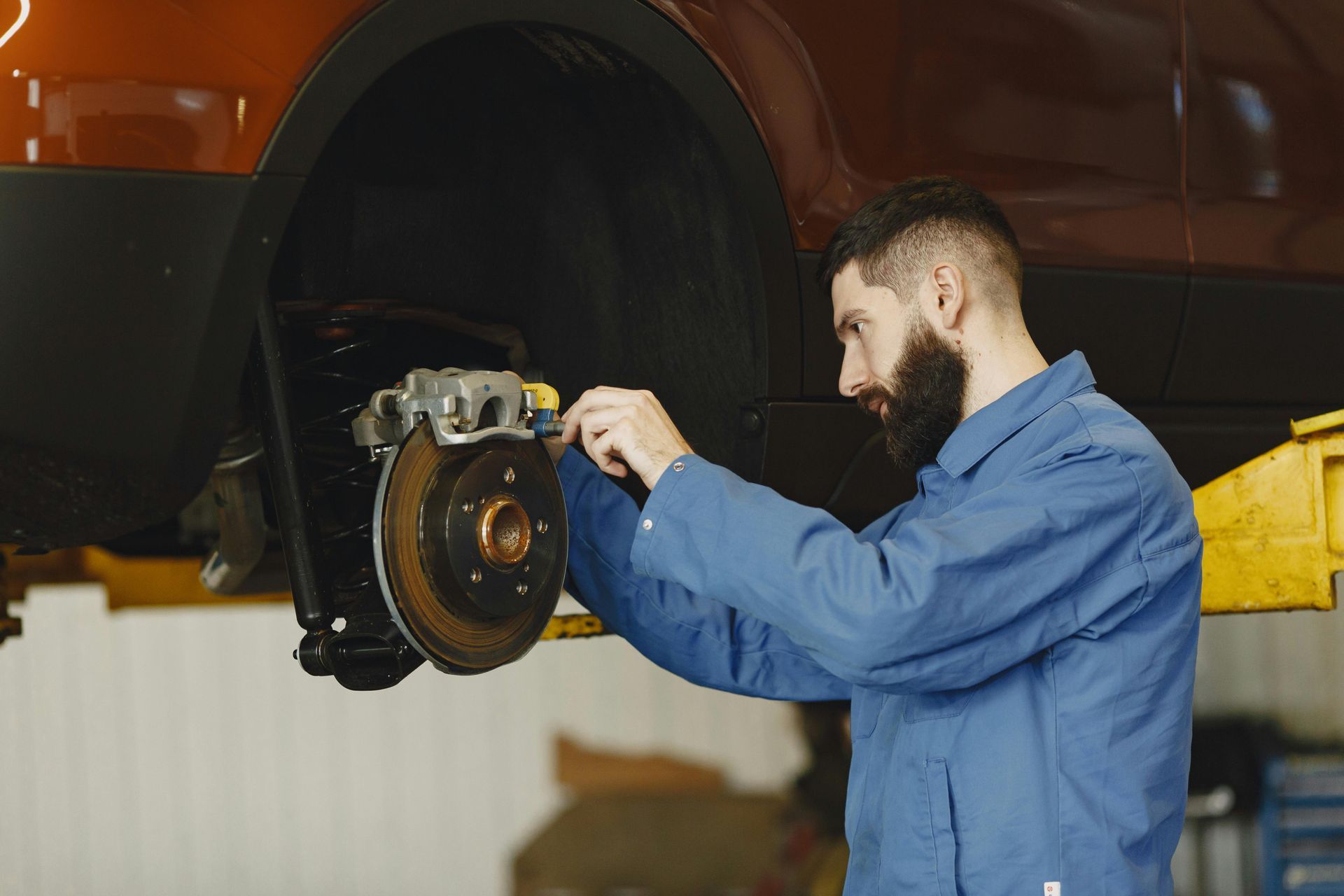How to Diagnose a Soft or Spongy Brake Pedal
A spongy brake pedal is one of the most common brake issues car owners face. It's that soft, mushy feeling when you press down on the brake pedal and it sinks too easily toward the floor. A spongy brake pedal usually indicates air or moisture in your brake lines, a brake fluid leak, or worn brake components that need immediate attention.
This problem shouldn't be ignored. When your brakes don't respond with firm resistance, your stopping power is compromised. Your safety on the road depends on properly functioning brakes, and that spongy pedal is your car's way of telling you something's wrong.
We see this issue in our shop frequently, and it's usually fixable without major repairs if caught early. If not, it can certainly affect the lifespan of your brakes.
Key Takeaways
- A spongy brake pedal indicates a problem in your brake system that requires immediate attention for your safety.
- The most common causes include air in the brake lines, fluid leaks, or worn components like master cylinders or calipers.
- Regular brake system maintenance and prompt response to any changes in brake pedal feel can prevent more expensive repairs and accidents.
What Are Spongy Brakes?
Spongy brakes refer to a condition where your brake pedal feels soft or mushy when pressed. Instead of a firm, responsive feel, the pedal sinks closer to the floor before engaging the brakes.
We often describe this sensation as "sponginess" because it resembles the way a sponge compresses under pressure. A healthy brake pedal should feel solid and provide resistance when you press it.
When you experience a spongy brake pedal, your vehicle's stopping power may be compromised. This isn't just an inconvenience—it's a serious safety concern that needs immediate attention.
Several issues can cause brake sponginess. Air in the brake lines is the most common culprit. Other causes include:
- Leaking brake fluid
- Worn brake pads
- Faulty master cylinder
- Damaged brake lines
We can usually diagnose spongy brakes during a standard inspection. The brake pedal should travel a specific distance before engaging, and excessive movement suggests a problem.
Remember, your brakes are your vehicle's most important safety feature. When they feel spongy, it's your car telling you something isn't right.
What Are the Signs of Spongy or Soft Brakes?
Recognizing brake problems early can save you from dangerous driving situations and costly repairs. When your brakes don't feel right, your vehicle is trying to tell you something important.
Sinking Brake Pedal
A healthy brake pedal should hold firm when pressed down. If your brake pedal sinks to the floor with little resistance, you've got a classic symptom of spongy brakes. This sinking feeling happens when air or moisture enters the brake lines.
We often see this in vehicles where the brake fluid is low or contaminated. The pedal might feel softer than usual, requiring more effort to stop your car.
Sometimes, you'll notice the pedal gradually sinks even while you're holding steady pressure on it. This is particularly dangerous because your stopping power decreases the longer you hold the pedal down.
Don't ignore this warning sign! A sinking brake pedal can indicate a serious leak in your brake system or failing master cylinder.
You Pump Your Brakes
Finding yourself pumping the brake pedal to stop effectively? That's not normal. When brakes work properly, one firm press should slow your vehicle predictably.
If you're pushing down multiple times to get stopping power, we're looking at a classic sign of air in the brake lines. The pedal might feel soft at first, then firmer with repeated pumps.
This pumping action temporarily compresses the air bubbles, giving you that firmer feel. But it's just masking a serious problem.
We see this issue frequently when brake fluid is low or when there's a small leak allowing air into the system. Your vehicle needs consistent hydraulic pressure for safe braking, not air pockets disrupting that pressure.
Your Brake Warning Light Is On
That little red or amber brake warning light on your dashboard isn't there for decoration. When it illuminates, your car's computer has detected a problem in the braking system.
A lit brake warning light often accompanies a soft brake pedal and could indicate low brake fluid levels. As fluid levels drop, air enters the system, creating that spongy pedal feel.
We check this immediately because it often points to a leak somewhere in your brake lines or components. The warning light might also signal uneven braking pressure or pad wear.
Don't continue driving with this light on! Your brake system needs professional attention right away. Even if the pedal feels mostly normal, the warning light indicates a developing problem that could quickly become dangerous.
The Causes of a Spongy Brake Pedal
A spongy brake pedal is typically caused by issues in the hydraulic braking system that reduce pressure or create inconsistency when you press the pedal. These problems can significantly impact your vehicle's stopping power and safety.
Brake Fluid Leak
Brake fluid leaks are one of the most common causes of a spongy pedal. When the hydraulic system loses fluid, it can't build proper pressure to operate your brakes effectively. Check around the master cylinder, wheel cylinders, and calipers for any wet spots or drips.
The brake master cylinder is particularly important to inspect. This component generates hydraulic pressure when you press the pedal. If its seals are failing, fluid can leak internally or externally.
Look also at the caliper seals on disc brakes. When these wear out, fluid escapes during braking. This makes the pedal feel soft and eventually leads to brake failure.
We can usually spot fluid leaks by the small puddles they leave under your vehicle. The fluid is typically clear to amber in color with a slippery feel.
Brake Hoses
Deteriorating brake hoses can cause spongy pedal problems. These flexible rubber lines connect your brake system to the wheels and can weaken over time.
When brake hoses age, they may develop tiny cracks or internal swelling. This creates a "balloon effect" during braking - the hose expands under pressure instead of transferring that pressure to your brakes.
Inspecting brake hoses requires looking for:
- Cracks in the rubber
- Bulging sections
- Soft spots
- Fluid seepage
Damaged hoses can't maintain consistent pressure in the hydraulic system. The pedal will feel firm initially but then sink toward the floor as you hold pressure.
We recommend replacing brake hoses every 5-6 years as preventative maintenance, even if they look fine externally. Internal damage isn't always visible.
Air in the Brake System
Air bubbles in your brake fluid create that spongy feel because air compresses while fluid doesn't. This is actually one of the most frequent causes we see in the shop.
Your brake system needs to be completely filled with fluid to work properly. When air enters the hydraulic system, it creates pockets that compress when you press the pedal. This gives you that soft, spongy sensation.
Air typically enters during:
- Improper brake bleeding
- Low fluid levels
- Component replacement
- Small leaks that allow air in
To fix this issue, we need to bleed the brakes. This process removes air from the system by pushing fresh fluid through while releasing the trapped air bubbles.
Proper bleeding requires working from the wheel farthest from the master cylinder and moving inward. This methodical approach ensures all air is removed from the hydraulic system.
Brake Fluid Contamination
Contaminated brake fluid can seriously affect your brake pedal feel. Over time, brake fluid absorbs moisture from the air, leading to decreased performance.
Water in the brake fluid lowers its boiling point. During heavy braking, this contaminated fluid can boil, creating vapor bubbles in the system. These bubbles compress just like air, giving you that spongy feel.
Other contaminants include:
- Dirt and debris
- Rubber particles from deteriorating seals
- Metal fragments from internal corrosion
The proportioning valve and ABS components are particularly sensitive to contamination. Dirty fluid can cause these parts to stick or function improperly.
We recommend changing your brake fluid every 2-3 years. Fresh fluid maintains its proper boiling point and keeps the hydraulic system working correctly, ensuring firm pedal feel and reliable stopping power.
Can I Drive With a Spongy Brake Pedal?
No, you should not drive with a spongy brake pedal. A spongy brake pedal is a serious safety concern that requires immediate attention.
When your brake pedal feels soft or spongy, it indicates a problem in your braking system. This issue could be caused by air in the brake lines, a brake fluid leak, or failing brake components.
We see this problem regularly in our shop. Driving with spongy brakes increases your stopping distance and could lead to complete brake failure at the worst possible moment.
Your vehicle's braking system is your primary safety feature. Any compromise to its function puts you, your passengers, and other drivers at risk.
Here's what to do if you notice a spongy brake pedal:
- Stop driving if possible
- Call for a tow truck to transport your vehicle to a repair shop
- Do not attempt to "pump" the brakes as a solution
- Never ignore this warning sign
If you absolutely must move your vehicle, do so with extreme caution. Drive at very low speeds, leave extra stopping distance, and avoid busy roads or highways.
The cost of a tow is far less than the potential consequences of driving with compromised brakes. We always recommend erring on the side of caution when it comes to brake issues.
If you need brake repairs, visit First Call Auto Care at 29444 Woodward Ave in Royal Oak, MI. Our experienced technicians will ensure your brakes function safely and quietly. Schedule an appointment today!
FAQs
How can air in the brake lines be detected and resolved?
Air in your brake lines typically causes a sponginess that gets worse when you press the pedal repeatedly. The pedal might feel soft and gradually sink to the floor.
We can detect air by bleeding each brake caliper or wheel cylinder systematically. Starting with the wheel farthest from the master cylinder, we attach a clear tube and open the bleeder valve while someone pumps the brakes.
The fix involves bleeding all four brakes until no more air bubbles appear in the fluid. This process may need to be repeated several times to ensure all air is removed.
What are the steps to take when your brake pedal feels soft with the engine running?
First, check your brake fluid level. Low fluid can cause a soft pedal and might indicate a leak somewhere in the system.
We recommend inspecting all brake lines, hoses, and connections for visible leaks or damage. Wet spots near wheels or under the car often reveal the problem area.
If no leaks are found, the master cylinder may be failing internally. This requires professional testing using a pressure gauge to confirm before replacement.
Sometimes the brake booster is at fault. We can test this by pumping the brakes with the engine off, then starting the engine. If the pedal suddenly drops, the booster is working but another component is failing.
What should be inspected during routine maintenance to prevent a spongy brake pedal?
Brake fluid should be checked regularly for both level and condition. Dark or cloudy fluid needs changing as it has likely absorbed moisture.
We inspect brake lines and hoses for cracks, bulges, or leaks every oil change. These components deteriorate over time, especially in areas with harsh weather.
Caliper and wheel cylinder seals need examination for leakage. Even small seeps can eventually lead to brake problems.
The master cylinder reservoir cap and seal deserve attention too. A faulty seal allows air and moisture into the system, causing sponginess over time.











